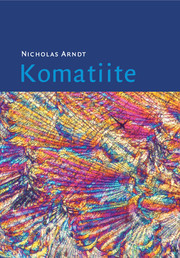Book contents
- Frontmatter
- Contents
- Preface
- Part I Background information – description of the field characteristics, mineralogy and geochemistry of komatiites
- Part II Interpretation – the manner of emplacement, the origin and the tectonic setting of komatiites
- 8 Physical properties of komatiites
- 9 Physical volcanology (by S. J. Barnes and C. M. Lesher)
- 10 Komatiite-associated Ni–Cu–PGE deposits (by C. M. Lesher and S. J. Barnes)
- 11 The hydrous komatiite hypothesis
- 12 Compositions and eruption temperatures of komatiitic liquids
- 13 Petrogenesis of komatiite
- 14 Geodynamic setting
- References
- General index
- Localities
- Plate section
12 - Compositions and eruption temperatures of komatiitic liquids
from Part II - Interpretation – the manner of emplacement, the origin and the tectonic setting of komatiites
Published online by Cambridge University Press: 27 August 2009
- Frontmatter
- Contents
- Preface
- Part I Background information – description of the field characteristics, mineralogy and geochemistry of komatiites
- Part II Interpretation – the manner of emplacement, the origin and the tectonic setting of komatiites
- 8 Physical properties of komatiites
- 9 Physical volcanology (by S. J. Barnes and C. M. Lesher)
- 10 Komatiite-associated Ni–Cu–PGE deposits (by C. M. Lesher and S. J. Barnes)
- 11 The hydrous komatiite hypothesis
- 12 Compositions and eruption temperatures of komatiitic liquids
- 13 Petrogenesis of komatiite
- 14 Geodynamic setting
- References
- General index
- Localities
- Plate section
Summary
Introduction
For various reasons it is essential to know the compositions of the silicate liquids that crystallized into komatiite lavas. Of particular importance is the maximum MgO content, because it is this parameter that best distinguishes komatiites from other types of magma. In this chapter I start by discussing the methods that have been used to estimate the liquid composition and then show that some komatiites formed from liquids containing at least 30% MgO, and perhaps as much as 34% MgO. This MgO content is far greater than that of other magma types (Table 12.1), and because most komatiites are essentially anhydrous, as we saw in Chapter 11, they must have formed in exceptionally hot parts of the mantle.
Methods used to estimate liquid compositions
If we need to establish the composition of modern basaltic lava, we can ask an adventurous colleague to go to the nearest active volcano to sample directly a still-active lava flow. With komatiites this is impossible and indirect methods must be adopted to estimate the liquid composition. The situation is further complicated by two factors: (a) alteration, which affects all komatiites and is particularly prevalent in the fine-grained or glassy samples that most closely represent quenched liquids; and (b) the facility with which olivine crystals are redistributed in cooling komatiite flows, which results in a wide spectrum of liquid compositions even in single flows and produces an even greater range of compositions of crystal-liquid mixtures.
- Type
- Chapter
- Information
- Komatiite , pp. 352 - 362Publisher: Cambridge University PressPrint publication year: 2008



